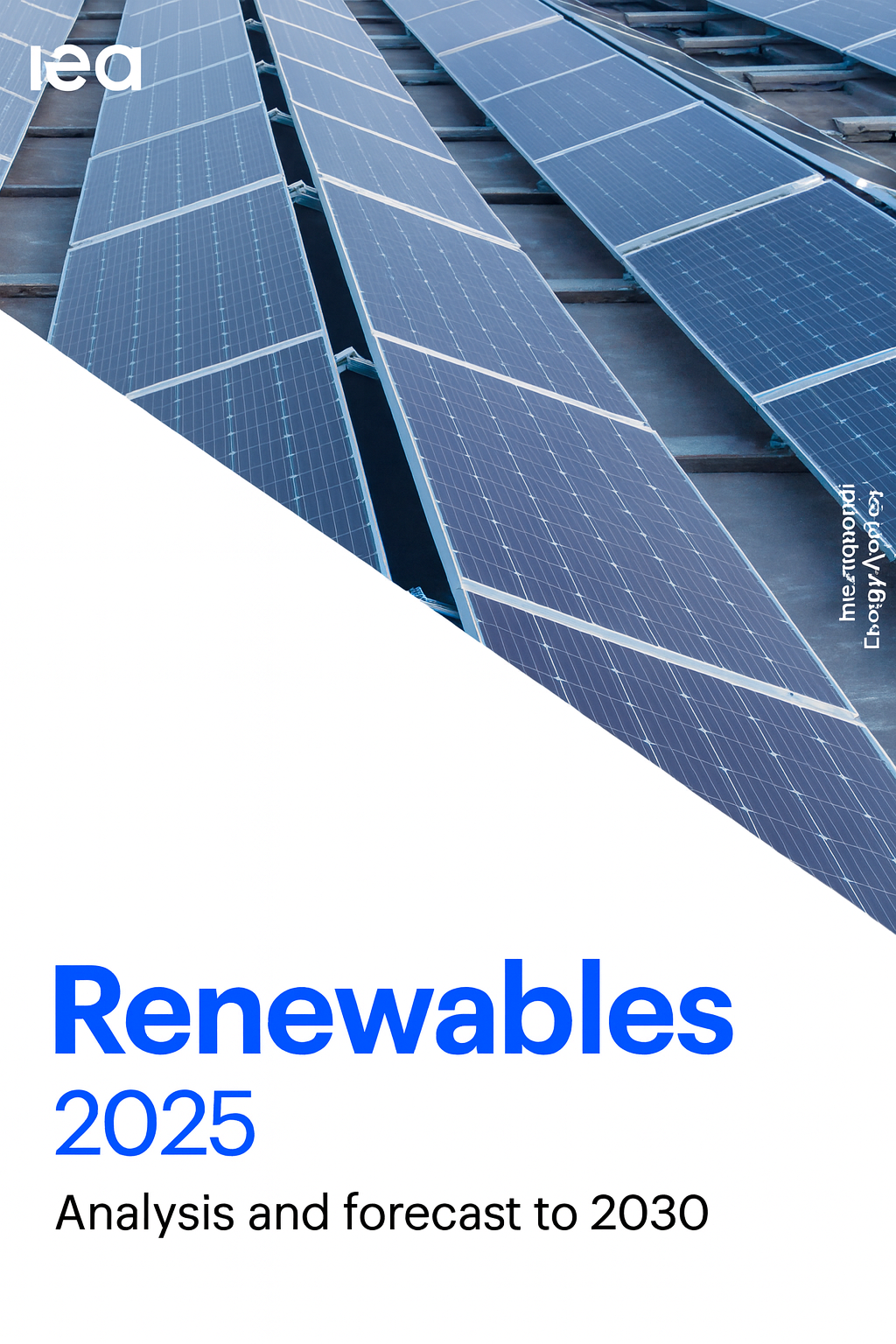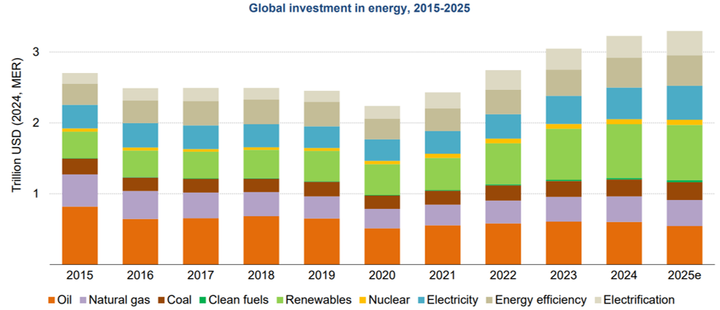The Digital Dividend: How Data Centers Are Rewriting the IEA’s Renewables 2025 Outlook
By 2030, renewables will supply 43% of global power—over 4,600 GW, twice 2022’s total. Yet nearly one point of today’s demand growth stems from “AI + AC.” Data centers, once grid burdens, now accelerate renewables—adding 110 TWh, or ~54 GW, of clean capacity by 2030.

The International Energy Agency’s Renewables 2025 report arrives at a pivotal juncture—a moment when the clean energy revolution is both maturing and mutating. The numbers are staggering: by 2030, global renewable electricity capacity will surpass 4,600 gigawatts (GW)—more than twice the 2022 total—and renewables will generate nearly 43 percent of the world’s electricity. This is not a marginal transition; it is the defining infrastructure buildout of the century.
At the core of this acceleration lies solar photovoltaics (PV), responsible for almost 80 percent of new renewable additions. In 2025 alone, the world is expected to install more than 750 GW of new renewable capacity—an unprecedented leap. Wind power, the stalwart of past decades, continues as the second pillar, though recent headwinds—supply chain friction, financing stress, and offshore cost inflation—have tempered short-term expectations. Offshore wind additions have been revised downward by roughly one-quarter from Renewables 2024, yet the long-term trajectory remains upward.
China remains the gravitational center of renewable growth, projected to account for nearly 60 percent of new global capacity through 2030. Europe advances steadily under the twin imperatives of energy security and decarbonization, while India embarks on a historic scaling of solar and wind, bolstered by domestic manufacturing and grid reform. In the United States, long-term policy momentum from the Inflation Reduction Act persists, though interconnection delays and local opposition have trimmed near-term deployment.
By the decade’s close, solar and wind together will generate nearly 28 percent of the world’s electricity. Yet amid the familiar optimism, one understated clause in Renewables 2025 signals a deeper inflection: the report attributes rising electricity demand in part to “services and commercial sectors linked to digitalization and cooling needs.” In that phrase lies a quiet revolution—the fusion of two great forces of the 21st century: clean energy and computation.
Electricity Demand Growth Projections
The IEA projects global electricity demand to grow about 3 percent annually through 2030, a modest but meaningful revision upward. In 2024, electricity demand surged 4.3 percent, the steepest increase in peacetime history, adding roughly 1,080 terawatt-hours (TWh) to the grid. Nearly 60 percent of that rise originated in buildings—driven not by lighting or appliances, but by air-conditioning and digital infrastructure. To understand the magnitude of these new forces, we translate narrative into arithmetic.
Step 1: Data Center Growth: According to the IEA’s Energy & AI report, global data center electricity use rose from ~460 TWh in 2022 to an expected 1,000 TWh by 2026. A smooth trajectory suggests an annual increment of roughly 135 TWh; conservatively, 100 TWh of new demand is attributed to 2024.
Step 2: Cooling Demand: The IEA attributes roughly 600 TWh of 2024’s electricity growth to the buildings sector, emphasizing cooling as the main driver. If 30–60 percent of that increase stems from air-conditioning, that equates to ~180–360 TWh.
Step 3: Combined Impact: Digitalization (data centers + AI) and cooling together contributed ~280–460 TWh, or 26–43 percent of 2024’s global electricity growth.
Step 4: Counterfactual Growth: Subtracting this uplift, global demand growth would have been 3.1–3.6 percent, not 4.3 percent—an adjustment of 0.7–1.2 percentage points.
| Driver | 2024 Increment (TWh) | Share of Global Growth (%) |
|---|---|---|
| Data centers (AI, cloud) | ~100 | ~9% |
| Cooling (air-conditioning) | ~180–360 | ~17–33% |
| Total (Digitalization + Cooling) | ~280–460 | ~26–43% |
Step 5: Projected Continuation
Assuming data center demand grows ~15 percent annually, and cooling normalizes, the IEA’s forecasted growth rates—3.3 percent (2025) and 3.7 percent (2026)—would drop to 2.3–2.8 percent and 2.7–3.2 percent, respectively.
| Year | IEA Headline Growth (%) | Ex-Digitalization & Cooling (%) | Demand Adjustment (TWh) |
|---|---|---|---|
| 2024 | 4.3 | 3.1–3.6 | 280–460 |
| 2025 | 3.3 | 2.3–2.8 | 240–400 (proj.) |
| 2026 | 3.7 | 2.7–3.2 | 300–450 (proj.) |
These calculations reveal that nearly one percentage point of modern demand growth is now attributable to “AI + AC.”
The Renewables Impact: Quantifying the Digital Uplift
In Energy & AI, the IEA explicitly links 110 TWh of additional renewable generation (2024–2030) to data center electricity use—AI being the dominant contributor. Converting this to capacity requires assumptions about technology mix and capacity factors.
| Technology | Share (%) | Generation (TWh) | Capacity Factor | Estimated Capacity (GW) |
|---|---|---|---|---|
| Solar PV | 70 | 77 | 0.20 | 44 |
| Onshore wind | 25 | 27.5 | 0.35 | 9 |
| Offshore wind | 5 | 5.5 | 0.45 | 1–1.5 |
| Total | 100 | 110 | — | ~54 GW |
Thus, absent AI and data centers, Renewables 2025 would forecast roughly 54 GW less renewable capacity by 2030—equivalent to the entire installed solar fleet of France and Spain combined.
The IEA identifies the United States as the largest locus of digital load growth, followed by China and Europe. Allocating capacity accordingly:
| Region | Incremental Generation (TWh) | Estimated Capacity (GW) | Technology Mix |
|---|---|---|---|
| United States | 55 | 27 | Solar-heavy; moderate wind |
| China | 33 | 16 | Solar + wind balance |
| Europe | 22 | 11 | Solar, onshore wind, small offshore |
| Global | 110 | ~54 | 70% solar, 25% onshore, 5% offshore |
This distribution reflects where AI and data center buildout is most aggressive—and where renewables are most responsive.
The Interdependence: Intelligence Meets Infrastructure
The once-linear relationship between electricity and GDP has fractured. Today, data centers are no longer passive consumers but active agents shaping generation portfolios and grid operations.
Early data centers drew criticism for energy intensity; hyperscale facilities now drive clean energy procurement. Through 24/7 carbon-free energy (CFE) commitments, companies like Google, Microsoft, and Amazon have become anchor customers for renewable projects, contracting more than 50 GW of clean power globally since 2020. The sector has effectively created a new class of offtaker—one that buys time-aligned energy, not just annual offsets.
AI training loads, while massive, are flexible. Unlike industrial processes, many can be shifted across hours or even days. This has given rise to “grid-interactive compute,” where data centers function as controllable demand assets. Emerging pilots in Virginia, Dublin, and Finland already curtail or time-shift compute to absorb renewable variability.
The next frontier is co-location: pairing data centers with solar, wind, and battery storage to create integrated microgrids. In Texas, Nevada, and Inner Mongolia, gigawatt-scale campuses are being designed with dedicated generation and 4–8 hour batteries, capable of islanded operation during grid stress events. This architecture turns data centers into stabilizers, not stressors—nodes of flexibility embedded within a renewable grid.
Strategic Implications
Policymakers
Governments should treat data centers as strategic infrastructure, integrating them into grid planning and incentivizing renewable co-development. Including digitalization in national demand models will prevent chronic underestimation of load growth. Aligning permitting and interconnection reforms with AI expansion is now a necessity.
Utilities and Grid Operators: Data centers represent both risk and reward. Clustering can overload transmission corridors, yet their flexibility and credit strength make them ideal partners for storage integration, demand response, and voltage support. Regulators should enable tariff structures that reward real-time flexibility and 24/7 carbon matching.
Renewable Developers and Supply Chains: The hyperscale boom is creating a durable floor under renewable demand. Corporate PPAs, once peripheral, now drive a third of U.S. solar procurement. Developers that integrate battery and compute co-siting will find new financing efficiencies and smoother interconnection pathways.
Data Center Owners and Developers: The new competitive frontier is energy intelligence. The winners will not simply consume energy but choreograph it—balancing AI workloads with renewable variability, leveraging storage, and trading flexibility into grid markets.
Conclusion: The Energy of Intelligence
In Renewables 2025, the IEA chronicles a world electrifying at speed. Yet the story between the lines is even more profound: the machines driving the digital revolution are also accelerating the clean energy transition. Without data centers and AI, global electricity demand in 2024 would have risen 3.1–3.6 percent, not 4.3 percent. Without their pull, the world’s renewables forecast would shrink by roughly 110 TWh of generation—about 54 GW of clean capacity.
But with them, the grid is evolving—not just expanding, but learning. The once-separate domains of energy and computation are converging into a single system of intelligence, where electrons and algorithms reinforce one another. Data centers are no longer endpoints of electricity—they are instruments of renewal.
In that symbiosis lies the blueprint for the next energy age: not power for intelligence, but power with intelligence.
References
- International Energy Agency. Renewables 2025: Analysis and Forecasts to 2030. Paris: IEA, 2025. https://www.iea.org/reports/renewables-2025.
- International Energy Agency. Energy and AI. Paris: IEA, 2025. https://www.iea.org/reports/energy-and-ai.
- International Energy Agency. Global Energy Review 2025. Paris: IEA, 2025. https://www.iea.org/reports/global-energy-review-2025.
- International Energy Agency. Electricity 2025. Paris: IEA, 2025. https://www.iea.org/reports/electricity-2025.
- S&P Global 451 Research. European Data Center Power Market Analysis. London: S&P Global, 2025.
- Brookfield Renewable Partners. “Microsoft and Brookfield Renewable Announce 10.5 GW Clean Energy Agreement.” Press release, May 1, 2024.
- Reuters. “Forget AI: Keeping Cool Is a Bigger Power Sector Problem.” Reuters, June 23, 2025.


